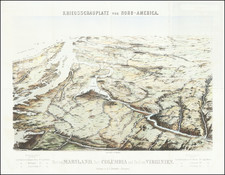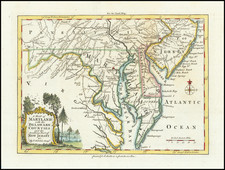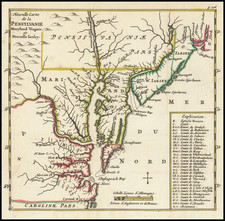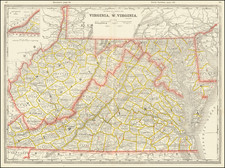One of the Primary Surveyors of Washington DC with Pierre L'Enfant and Andrew Ellicott Surveys the Giles Estate on Hampstead Hill
Future Site of the Battle of Baltimore
Detailed hand drawn survey map of a parcel of land on Hampstead Hill, drawn by Charles de Krafft for Jacob W. Giles (1776-1851).
The map shows the area which was apparently the home of, or otherwise, owned by Jacob W. Giles a leading citizen of Baltimore. It is possible that this is the same Giles whose house appears just north of the terminus of Market Street at Perry-Hill Road on Warner & Hannah's 1802 Plan of the City and Environs of Baltimore. Early details noted on the map reference Hempstead Hill Street and Mountenay's Neck, a strip of land which seems to have been between Old Town and Fells Prospect (Fells Point) on the earliest Baltimore maps.
The area in question would seem to be in or near today's Patterson Park. Prior to its becoming a park in 1827, Hampstead Hill, the highest point in the park, was a meeting point for the local Militia in the first decade of the 19th Century. As the British threat loomed over Baltimore in 1814, the Hill became a strategic point in the city's defense during the Battle of Baltimore. The extensive fortifications constructed here, including trenches and earthen berms, were part of a larger defensive strategy that proved decisive in the confrontation with British forces, including the construction of Rodgers Bastion, a redoubt that anchored the city's eastern defense line. When British troops advanced on September 13, 1814, they encountered a robust American force, bolstered by significant artillery. The unexpected strength of these defenses contributed to the British retreat and the subsequent American victory.
“Mountenay’s Neck” was part of a patent of 299 acres originally granted to Alexander Mountenay, extending on both sides of the Hartford run into “old town,” this property, escheated by the Fells and others, was claimed by Mountenay’s heirs, and a good deal of litigation resulted.
The map was executed by Charles de Krafft, an eighteenth-century American draughtsman and surveyor whose career included the creation of at least 4 manuscript Revolutionary War Battle Plans. De Krafft served as one of the primary draftsmen for Pierre L'Enfant during the 1791 planning of Washington, D.C. and drafted a manuscript map of a part of the Ohio Valley for Thomas Jefferson, which Jefferson used to extra illustrate his personal copy of his Notes on the State of Virginia (See the biography section below for a full treatment of de Krafft's life and work.)
De Krafft's later life as a surveyor would take him from upstate New York to Philadelphia and the Baltimore area, as well as important engagements in Washington DC and in the survey Spanish West Florida and Mississippi Territory, following the signing of the Pinckney Treaty with Spain in October 1795.
Includes the following note:
A Map of Hampstead Hill
Within one mile of Market Street Bridge in the City of Baltimore on which is erected a dwelling house dairy and kitchen with a carriage house and two stables an elegant garden & very valuable Springs
Jacob W Giles
Charles de Krafft Survey Maps
We note the following locations for surviving examples of survey plans by De Krafft:
- Bryn Mawr College
- Historical Society of Pennsylvania (MS collection 346, being a volume of his work; also, MS collection 25, the Chew papers)
- Library of Congress (two neat plans)
- William L. Clements Library, University of Michigan.
Charles de Krafft was born Johann Carl Phillip von Krafft and is also known as John Charles Phillip von Krafft.
Overview
De Krafft led a remarkable life. He arrived in America in 1778 as a trained Prussian Military Officer, who had spent the prior two years as a mercenary and privateer. After failing to gain a commission at Valley Forge from George Washington, he joined the British in Philadelphia, receiving a commission in a Hessian Unit led by George Hanger. During this time, he credated a number of excellent manuscript battle plans.
Following the war, de Krafft returned to America, joining his wife and young son in New York City in 1784. He would obtain a position as a surveyor, which took him to Philadelphia and the Washington DC area by 1789, where he was known to have worked on at least one manuscript survey by John Hills. De Krafft is also known to have worked with Reading Howell in Philadelphia (The Independent Gazette, March 31, 1792).
De Krafft's most important post-War engagement was as one of the primary assistants of Pierre L'Infant in the original survey and mapping of the District of Columbia. Following L'Infant's dismissal, de Krafft stayed on and worked with Andrew Ellicott on the completion of the survey of Washington and the District of Columbia.
In this same time frame, he prepared original surveys and made copies of other surveys for Thomas Jefferson, the Penn Family and Robert Morris.
From about 1796 to 1800, de Krafft served with Andrew Ellicott during the survey of the line between Spanish West Florida and Mississippi Territory, following the signing of the Pinckney Treaty with Spain in October 1795.
De Krafft settled in Washington, DC, working as as surveyor and draughtsman. His son would go on to become one of the first City Surveyors of Washington, DC. Toward the end of his life, in 1804, De Krafft was visited by Alexander Von Humboldt, a family friend, during Humboldt's 2 week stay in Washington D.C. enroute back to Europe from Mexico. De Krafft was quite likely present when Humboldt briefed Jefferson and others on the cartographic and other information about Northwestern New Spain during his time in Mexico.
Biography
Johann Karl Philip von Krafft (1752–1804) was born in Dresden to a career military family. Krafft was commissioned an ensign in 1773 in the Prussian army under Frederick the Great. He resigned his commission in 1776, desiring greater adventure in another army. Between 1776 and 1778 he travelled to Russia, Denmark and Quebec unsuccessfully seeking a new officer's commission with a brief service as an American privateer.
Von Krafft attempted to secure a commission from George Washington in the Continental Army at Valley Forge in early 1778, but when he could not obtain an appointment as an officer, he crossed the lines into British-occupied Philadelphia and joined one of the German regiments fighting for the British. Krafft saw action at Monmouth and spent the remainder of the war with Henry Clinton's Army at New York.
At the close of the war, Krafft married Miss Cornelia de la Metre in New York. After returning with the British Army to England in 1783, he returned to America the following year where he supported his family in New York as a teacher. He then obtained a position as a surveyor and draftsman for the United States Treasury Department, a position he held until his death.
In a letter written by Baron von Steuben to Lachlan McIntosh sold at RR Auction on December 15, 2012 (Lot #1032), Van Steuben writes, in full,
New York . June 1st 1784
This will be delivered you by Mr de Kraft [J. C. von Krafft] a Gentleman of an exceeding good family in Saxony who came over to this Country in the Services of the Prince of Hesse—but marrying in this place a Girl of no fortune and being on that account deserted by his Parents he has returned to this Country with the View if possible to establish himself[.] Mr de Kraft has had a good education, is well acquainted with the Military Mathematics and is an excellent Draughtsman he has some knowledge also of Civil Architectures—If in the business of Surveying land—as an engineer—or as any other line he can find employ for his talents I have no doubt he will render himself both useful and agreeable—Permit me my dear Sir to solicit your protection for him in Georgia, he wishes to establish himself in that state and if you can in any matter second his Views or afford him any assistance, I shall be such obliged to you.
The Magazine of American History (1888) volume 19 (pages 183-84) gives a precis of his biography in a review of his Revolutionary War journal, which was published by the New York Historical Society:
Von Kraft was born in Dresden, Saxony, in 1752, and is said to have belonged to a baronial family; he was related to many persons of rank in Prussia and Saxony. At twenty-one he was commissioned ensign in General von Luck's regiment of fusiliers in the Prussian army under Frederick the Great, and was promoted the same year. In seeking advancement three years later he resigned his commission, and after visiting Russia and wandering over Europe, he sailed for America, where he served in the Revolutionary War under Von Donop, and later on under Von Bose. He married in New York, and after the government was established under the Constitution, was employed as surveyor and draughtsman to the Treasury Department. In connection with his journal he made several maps and sketches…notably the plan of the battle of Trenton, with explanations, the battle-ground at Monmouth, the plan of Red Bank fort, in New Jersey, the plan of the region between Philadelphia and Valley Forge, with the several positions occupied by the British and the Americans, a sketch of New London and Groton-town, and the plan of the military positions on Manhattan Island, all of which are of exceptional historic interest and value.
On the 4th of January, 1780, Von Kraft writes: “On men-guarde in Wall street.” In the same connection he records as follows: “The cold was so intense this winter that the inhabitants could not remember the like for twenty years back. The North River was wholly frozen over, and the East River had an astonishing quantity of floating ice. As, in spite of this, many people ventured out in boats, sad accidents happened almost daily. The wood magazines were emptied, and as we could not get our wood from Long Island on account of the ice, old ships were assigned to all the English and Hessian regiments for firewood. Even then we had only half allowance and the other half was to be paid to us. The Rebels had now the best opportunity to attack us from all sides to the best advantage. We expected it hourly, and therefore the best measures were taken.”
As a mapmaker, De Krafft had an exceptionally diverse output; he is recorded as the author of a descriptive watercolor of the Spruce Street Jewish Cemetery in Philadelphia, "showing plan of burial ground"; he is credited as the compiler for Osgood Carleton's “Plan of Part of the District of Maine” (1793); he drew a manuscript map of the Native American mound fortifications which was bound into Thomas Jefferson's own copy of Notes of Virginia; and most importantly, he worked with Pierre L'Enfant to lay out Washington, D.C. in 1791. Pamela Scott writes, in Capital Engineers (2012):
The Georgetown Weekly Ledger of July 2, 1791, reported that “a large number of gentlemen attending, a plan of the city, which had for several weeks occupied the time and talents of Colonel L’Enfant, assisted by the Baron de Graff, and which, with some small alterations [Washington] had determined to adopt” was shown to the public. Scholars have long speculated who “Baron de Graff” was. In 1800 “Charles de Krafft, Surveyor and Draftsman” advertised in a local newspaper that he “was employed by [the] government in the year 1791 (at Georgetown) to assist Major L’Enfant to plan and lay down the first draft, for the city of Washington.”
In the Biographical Sketch written by Thomas Edsall in 1887 which accompamies the published version of de Krafft's Revolutionay War Journal, Edsall writes:'
A few months before Krafft's death, Baron von Humboldt, who had known him and his family in Germany, spent several days on a visit to Krafft, at his home in Georgetown. Humboldt informed him of the death of his mother, with whom he had ceased to correspond for many years, and advised him to return to Germany and lay claim to his estate, which was in the possession of a venerable maiden relative. He had made his preparations to do so, when he was seized with an attack of congestion of the lungs, which terminated his life, July 24, 1804. Mr. de Krafft was a man of commanding presence and of courtly and fascinating manners. He had a quick temper, and was sensitive to affronts. During his military service— 1770 to 1784— he was the principal in some twenty duels, and was several times severely wounded. His descendants have held responsible positions and high rank in the civil service and naval service of the United States.









![[ Middle British Colonies Map ] Pensilvania Maryland and Virginia](https://storage.googleapis.com/raremaps/img/small/98228.jpg)




![Carte Particuliere de Virginie, Maryland, Pennsilvanie, La Nouvelle Jarsey. Orient et Occidentale [Heighten in Gold!]](https://storage.googleapis.com/raremaps/img/small/61392mp2.jpg)